When purchasing a new TV, the buyer pays attention to its screen size, image clarity and rich colors. It is these parameters that allow you to watch films recorded using the most modern technologies. A few years ago, screens with Full HD resolution, a high-definition image format, were the ultimate dream. Today it has already been supplanted by 4K, which is four times higher than Full HD in clarity, and 8K is already on sale. You can fully appreciate the image quality of such devices only on the big screen. The cost of models with the largest diagonal is too impressive, and 40 or 50 - inch devices are not large enough for that. Therefore, 70/75 - inch devices are in high demand among moviegoers. The editorial staff of the site "bestx.htgetrid.com/en/" offers visitors an overview of the best TVs with a diagonal of 70-75 inches for 2020, based on customer reviews and expert opinion.
Content
- 1 A few words about the evolution of TV receivers
- 2 What is LCD
- 3 Matrix device
- 4 LED TV
- 5 OLED and LED, what's the difference
- 6 QLED and Nano Cell
- 7 A few words about permission
- 8 What are the resolution formats
- 9 Criterias of choice
- 10 Top manufacturers
- 11 How to distinguish a fake
- 12 Where can I buy
- 13 Rating of high-quality TVs with a diagonal of 70-75 inches
- 13.1 10. Erisson 75ULEA99T2
- 13.2 9.LG 70UM7100 70 '' (2019)
- 13.3 8. Sharp LC-70UI7652E 69.5 "
- 13.4 7. Panasonic TX-75FX780 74.5 "
- 13.5 6. Philips 75PUS6754 75 "
- 13.6 5. Samsung UE 75RU 7100U 74.5 "(2019)
- 13.7 4. Xiaomi Mi TV4 75 74.5 ''
- 13.8 3 Sony KD-75XG8096 74.5 "(2019)
- 13.9 2 QLED Samsung QE75Q60RAU 75 "(2019)
- 13.10 1 OLED Sony KD-77A1 76.7 "
A few words about the evolution of TV receivers
The modern TV receiver is seriously different from the models of the last century. Then the choice was not particularly great: color or black and white, large or small, and that's it. The image quality was the same for almost all products, there were no settings, and there was not much to adjust.
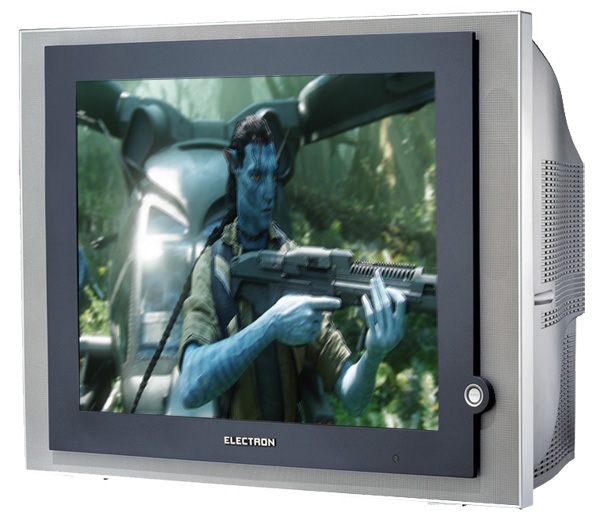
A TV today is a device with numerous functions that allow it to be used as:
- a receiver of broadcasting channels;
- personal computer;
- home theater;
- means of communication (for those who like to communicate on Skype).
Such a device has a lot of parameters, characteristics and settings. This is a serious purchase, including the price. In order not to be mistaken in the choice, it is necessary to understand the features of various models, to understand what determines the clarity and brightness of the picture, and to understand what some terms mean.
What is LCD
Long gone are the CRT models with a cathode ray tube (CRT). The image of modern devices is formed by a matrix on liquid crystals. The latter concept is worth considering in more detail.
As you know, crystals are called solid substances with an ordered internal structure - a crystal lattice. Crystals are anisotropic. This means that light or electromagnetic waves, passing through the crystal, change their properties, depending on the direction of passage.

Liquid crystals have the properties of liquids. They can be poured into glasses. Nevertheless, their molecules are located throughout the volume in a certain order, and these are the properties of crystals. The main feature of liquid crystals is that the orientation of their molecules changes under the influence of an electric field. This property is used in the manufacture of TVs, monitors, tablets, smartphones and other gadgets.
Interesting! LCD - Liquid crystal display, liquid crystal display.
Matrix device
The main element of a TV receiver consists of a huge number of liquid crystal cells called pixels. In turn, each pixel is made up of three subpixels, each with its own color: red, green and blue (Red, Green, Blue or RGB).

An electric field acts on liquid crystals, forcing their molecules to line up in a certain order, allowing or blocking the passage of light through them. This is how the image is formed.
Changing the brightness of the subpixels allows the human eye to distinguish a huge number of shades. Such a set is called an RGB matrix.
Interesting! Pixel is an abbreviation for the English pictures element, literally - a picture particle.
LG has developed an RGBW matrix with four subpixels, adding white (Wait) to the three primary colors. Disputes of experts about which option is better still do not subside.
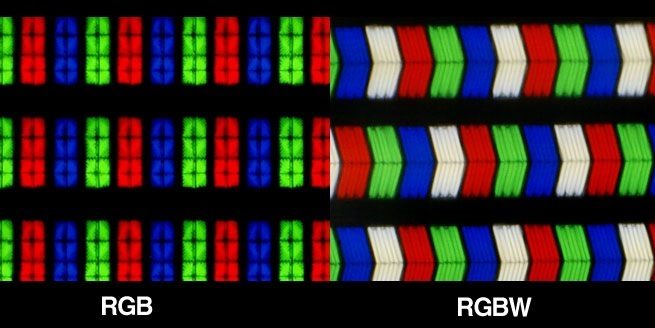
LED TV
Subpixels are like light filters. To form a color image, a light flux must be passed through them. There are several ways to highlight:
- Fluorescent lamp. Used in the first LCD models. The picture quality of such devices was worse than that of plasma panels.
- LED, or LED (Light-Emitting Diode). Completely replaced the lamp. It is implemented in several ways, each of which has its own advantages and disadvantages and affects the image quality. There are many LED models with different characteristics.
- Full array LED backlighting. The very first option, in which the LEDs are located evenly over the entire surface behind the matrix. There is no local dimming function. Full array with local dimming function provides the best picture quality to date. With this option, dark areas become even darker, light areas are highlighted. The contrast increases, the colors become richer.
- Side. LEDs are located at the edges, often on the right and left, and then the light goes along the light guides. The method allowed to reduce the thickness of the TV receiver, but did not affect the picture quality in any way.
- The advanced version of the sidelight with local dimming significantly improves contrast and color reproduction, it is cheaper than the option with full array and local dimming, although it is slightly inferior in image quality.
OLED and LED, what's the difference
OLED is short for organic light-emitting diode. Each pixel of an OLED panel emits light when exposed to an electromagnetic field, i.e. backlighting is not needed here. Moreover, the brightness of the glow of each pixel is also adjustable. OLED is the best contrast and saturation of colors and shades. Of course, this description is very schematic and does not reflect the complexity of the device. Like any device, OLED panels have their advantages and disadvantages.
The advantages include the following properties:
- no need for backlighting;
- thin and lightweight bodies;
- fast pixel response to color change;
- better black depth, as a result - better contrast;
- the picture does not lose clarity and rich color when changing the viewing angle;
- consumes less electricity.
There are two disadvantages, but they are very significant:
- pixels in OLED panels burn out faster;
- OLED panels are more expensive.
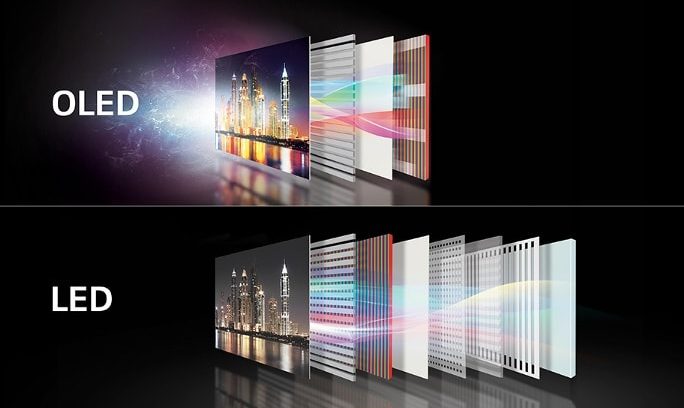
QLED and Nano Cell
Panels made using quantum dot technology. Both QLED and Nano Cell panels are advanced versions of LED TVs. The first is used in its models by Samsung, the second - by LG.
Unlike conventional LED panels with white backlighting, QLED technology uses LEDs for backlighting, producing a powerful blue tinted light output. The QLED panel is covered with a special film material containing red and green polynomial dots. Moreover, each green dot is 30, and the red is 50 atoms. These dots or nanoparticles are capable of emitting colors of the desired tones under the influence of an electromagnetic field. Thus, the best brightness and color saturation is achieved.
Interesting! At first, the technology of quantum dots was called Quantum Dot. Then, apparently by analogy with OLED, it was called QLED. Such a marketing ploy.
QLED and Nano Cell have emerged as more affordable alternatives to OLED panels.They outperform OLED panels in terms of brightness and color saturation, durability.
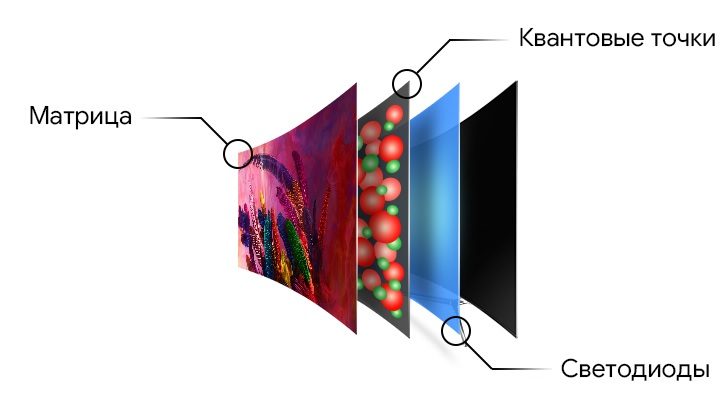
A few words about permission
When choosing a TV, we want:
- get a clear image;
- see as much information as possible.
The implementation of these wishes depends on the screen resolution, i.e. on the number of pixels that make up its surface. Pixels can be of different sizes. The smaller the pixel, the sharper the image will be. As an example, consider two TVs, 32 and 50 inches in 4k format. The sizes are different, but the number of pixels is the same.
Important! When buying a TV with a large diagonal, choose the device with the highest resolution.
What are the resolution formats
The parameter is determined by the ratio of the number of pixels horizontally and vertically. There are several standard image formats. Not all are used by TV manufacturers. Some are hopelessly outdated, others have lost demand, and it is unprofitable to produce such equipment.
- SD. An outdated version of standard definition 720x480p. Used in the first televisions. Such devices are no longer produced, but there are on-air television broadcasts and video recordings in this standard and there are quite a few of them.
- HD. High definition - high resolution 1280x720p. The first of the high quality television standards.
- Full HD, in translation - full high resolution, 1920x1080p. Until recently, such devices were the coolest and most expensive. In this version, PC monitors and smartphone displays work.
- UHD or 4K - Ultra HD, with a resolution of 3840x2160. The very concept of "ultra" suggests ultra-high definition television. This is already a digital standard.
- 8K (7680x4320p) is the second ultra-high definition digital standard, twice as steep as 4K.
With the advent of high definition television, screen sizes have also changed. It is about the ratio of the width and height of the image. In CRT models this ratio is 4: 3, i.e. the screen is a rectangle, the width of which is always greater than the height by one accepted unit of measurement. For HDTVs, a standard has been developed with a width-to-height ratio of 16: 9.
Criterias of choice
After getting acquainted with the characteristics and capabilities of modern TV receivers, the question "how to choose the right device" remains open. The abundance of terms is confusing. Perhaps it is worth considering some criteria that will help the buyer decide finally.
Why 75 '' diagonal
For Full HD, 40 or 50-inch TVs are enough. The brightness and clarity of the image will be fine. Enjoy the quality of movies from Blu-ray discs or high quality content from the Internet with 4K. True, video equipment of this class also costs a lot of money. 70-75 inches for such a case is the best option.
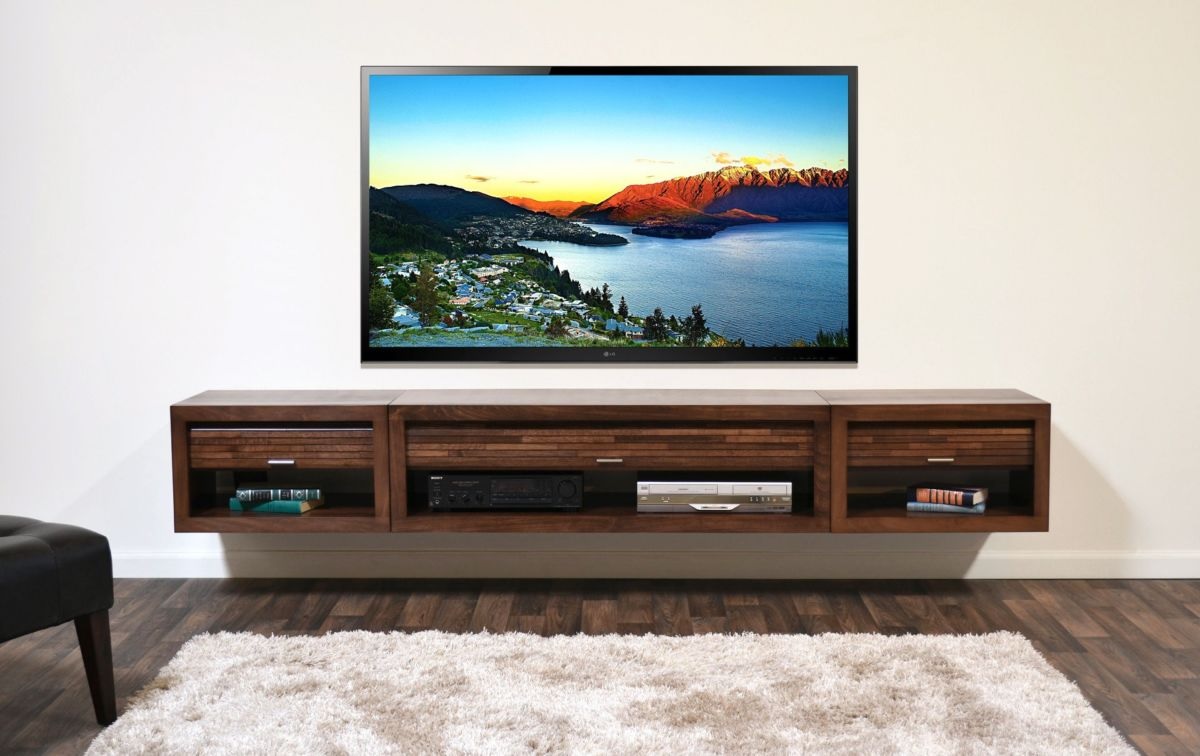
The size of the room for models of this size matters. However, the statement that the distance from the eyes to the screen should be at least three or four of its diagonals is very controversial, especially for 4K TV and, moreover, 8K. If the viewer is comfortable, he can sit and one and a half steps from the TV receiver. The criterion here is the distance from which pixels can be distinguished on it. If positioning a device of this size is easy, 75 ”is a great choice.
What depends on the refresh rate of the screen
At a low refresh rate, movement on the screen may be blurry. This indicator, depending on the model, varies from 50 to 800Hz. However, you shouldn't chase quantity here. 120Hz in 4K TV should be sufficient. All that is greater is "from the evil one." The human eye cannot tell the difference.
Which resolution to choose
HD is likely a thing of the past. FULL HD panels meet the definition of "ultra high definition". 4K and 8K standards will be needed to view ultra high definition (UHD) content. When choosing a TV, you need to understand that there are very few signal sources of such clarity, and those that exist are on the Internet and on Blu-ray discs. Most terrestrial channels on such devices will look worse than on FHD.
Why OLED, QLED and Nano Cell are needed
These abbreviations cover the matrix manufacturing technologies. OLED is the most expensive option. You can easily find LED TV with local dimming and enjoy high quality picture.
QLED and Nano Cell represent a further development of the already known LED technology.The color gamut is reproduced with an accuracy of up to 99% and the brightness is practically not reduced. With HDR, which enhances the capabilities of standard technologies, the picture quality is not much different from the natural one. And the cost of the QLED panel is much lower than that of the OLED model.
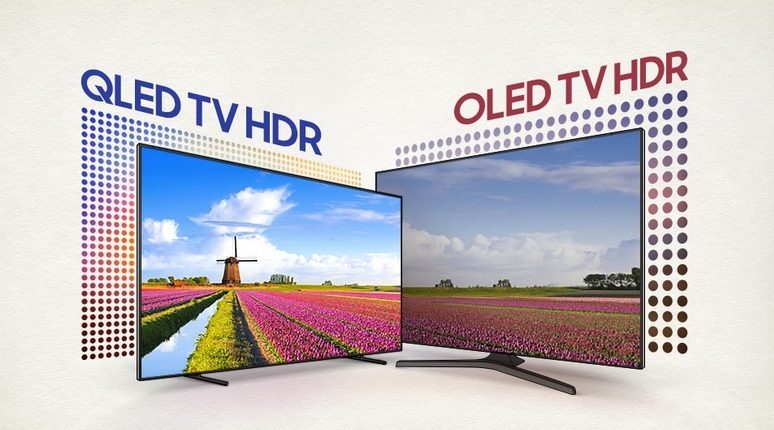
What to look for
In addition to demonstrating high-quality images of terrestrial channels, a modern TV is endowed with a lot of interesting additional functions. It is worth getting to know them better:
- Smart TV. Integration of Internet services into the hardware of the TV receiver. Allows you to show movies and roles from YouTube, play network games, etc.
- The Serif. Samsung corporation developers together with French designers have released the original interior QLED Samsung TV Serif. By various techniques, the cable routing is hidden from the user's eyes and the device resembles a notice board on its own legs. Ambient mode allows the panel to completely merge with the background (chameleon), display art canvases on the screen even when it is turned off. An apparatus mounted on a wall can be mistaken for a painting.
- The Frame. Another interior TV from Samsung will be a (dynamic) decoration for your home.
- Airplay support 2. Ability to transfer data from your iPhones and iPads to TV. Joint development of Apple and Samsung.
- Supports DVB-T2, DVB-S, DVB-C. Such marks mean that watching digital channels on them is possible without installing additional TV tuners. DVB-S allows you to watch digital broadcasting from a satellite dish, DVB-T for demonstrating digital channels from a conventional antenna and DVB-C for cable TV. The number 2 indicates their second version.
- Premium UHD TV. This designates devices that are completely ready to receive and display HDR content.
In addition to the listed useful additions, the modern "zomboy" is equipped with various inputs for USB and HDMI connectors, providing the ability to work with removable media and a PC. Wi-Fi and Bluetooth enable wireless communication with the TV receiver of your smartphones and tablets.
Top manufacturers
Which company is the best TV to buy? There is nothing to think about. The names of companies and corporations that produce the best consumer electronics are on everyone's lips:
- The South Korean corporations Samsung and LG produce perhaps the most popular TV receiver models.
- The electronics of the Japanese companies Sony, Panasonic, Toshiba, Hitachi, Sharp are constant innovations + high build quality.
- Chinese Xiaomi, TCL - high quality budget models.
- French company Thomson. High quality TV receivers.
- Dutch firm Philips. The popularity of her models is due to the stylish design, high build quality and the use of new technologies.
- The Russian company Erisson is a manufacturer of inexpensive modern TV models.
When choosing brands, it is better for an inexperienced buyer to listen to the advice and recommendations of advanced users and sellers of specialized stores, carefully read the description and user manual, and clarify how much the device costs.
How to distinguish a fake
There are several fairly simple ways:
- Compare the serial numbers on the packaging, case and warranty card. If they do not match, the device is fake.
- They will try to sell you a "copy" of a branded product without a warranty card.
- Branded packaging film has holographic marks, and in their absence it is pleasantly smooth. If there are no signs and the film is pricked, you are "forced" with a fake.
- Look for quality metal finishes. On the original models, the joints are processed with high quality and are almost invisible.
Where can I buy
It is best to do this in a specialized store in order to "touch" the product with your own hands and eyes. Can be ordered online from the online store. Store addresses can be spied on Yandex - market.
Rating of high-quality TVs with a diagonal of 70-75 inches
10. Erisson 75ULEA99T2
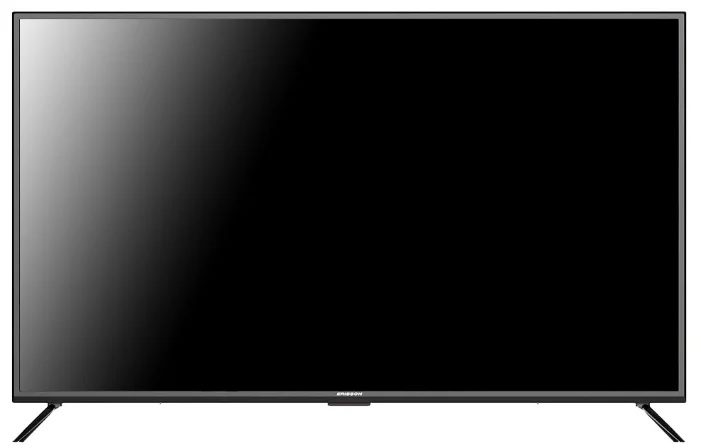
The device of the Russian brand, with an ultra clear 4K UHD image, will allow you to immerse yourself in the world of cinema. The sleek design will adorn the modern home. With the Smart TV function, the user will be able to view high-quality content from the Internet, and the Wi-Fi module will help to connect to the World Wide Web without wires.
Advantages:
- large viewing angle;
- Smart TV;
- affordable price.
Disadvantages:
- housing made of cheap plastic.
| Erisson UE 75RU 7100U 74.5 '' | LCD TV |
|---|---|
| Diagonal screen size | 75 '' = 189 cm |
| Format | 1970-01-01 16:09:00 |
| Resolution | 4K UHD (3840x2160p) |
| Backlight | LED |
| Built-in acoustics | 2x10 W |
| entrance | HDMIх3; USBх3; Ethernet; Bluetooth; Wi-Fi; VGA |
| Additionally | Local home network (DLNA) support |
| Smart TV implementation | On Android platform |
| Dimensions mm. | 1682x1031x331 |
| Weight | 34.4 kg |
| average price | 61,120 rubles |
9.LG 70UM7100 70 '' (2019)
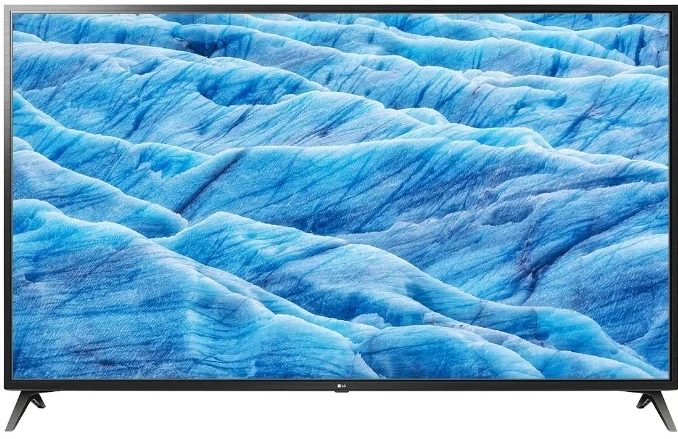
Last year's novelty from the South Korean giant LG Electronics receives the best customer reviews. A relatively inexpensive device. The VA LED-backlit matrix provides wide viewing angles without losing color saturation. The lack of local dimming slightly reduces contrast. Additional opportunities for viewing high-quality content are realized with the Smart TV function, USB ports, HDMI, support for digital formats DVB-T2, DVB-C and DVB-S2. According to buyers, the LG 70UM7100 70 '' model is an excellent value for money.
Advantages:
- wide viewing angle;
- fits into the "smart home" system;
- VA matrix with LED Direct backlight;
- relatively low cost.
Disadvantages:
- no local dimming.
| LG 70UM7100 70 '' (2019) | LCD TV |
|---|---|
| Diagonal screen size | 70 '' = 178 cm |
| Format | 1970-01-01 16:09:00 |
| Resolution | 4K UHD |
| Backlight | LED, full array |
| Matrix | TFT VA |
| Built-in acoustics | 2x10 W |
| entrance | HDMIх3; USBх2; Ethernet; Bluetooth; Wi-Fi; Miracast |
| Additionally | Local home network (DLNA) support |
| Smart home compatibility | LG ThinQ |
| Dimensions mm. | 1578x913x91 |
| Weight | 30.4 kg |
| average price | 56480 rubles |
8. Sharp LC-70UI7652E 69.5 "
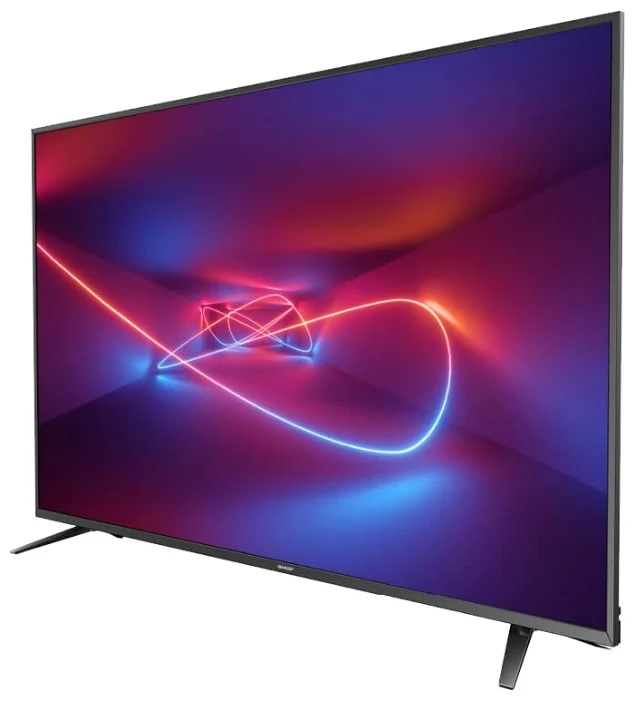
LED TV in 4K UHD format from the famous Japanese corporation Sharp. Brand device of high quality assembly with full functionality of a modern TV receiver. The VA type LED array is illuminated throughout the array. The viewing angle reaches 178 °. There are USB and HDMI connectors for working with "attachments". Wireless connection with tablets and smartphones is provided by Wi-Fi and Bluetooth modules. There is support for digital formats DVB-T2, DVB-S2 and DVB-C. Smart TV function implemented. Built-in acoustics from three speakers, including a 20-watt subwoofer, allow you to enjoy surround sound.
Advantages:
- surround sound;
- large viewing angle;
- relatively affordable price.
Disadvantages:
- local dimming is not provided.
| Sharp LC-70UI7652E 69.5 '' | LCD TV |
|---|---|
| Diagonal screen size | 69.5 '' = 177 cm |
| Format | 1970-01-01 16:09:00 |
| Resolution | 4K UHD (3840x2160p) |
| Backlight | LED, full array |
| Matrix | TFT VA |
| Built-in acoustics | 2x10 W + 1x20W |
| entrance | HDMIх3; USBх3; Ethernet; Bluetooth; Wi-Fi; AV; Miracast |
| Additionally | Local home network (DLNA) support |
| Smart TV implementation | Yes |
| Dimensions mm. | 1578x907x79 |
| Weight | 28 kg |
| average price | 77380 rubles |
7. Panasonic TX-75FX780 74.5 "
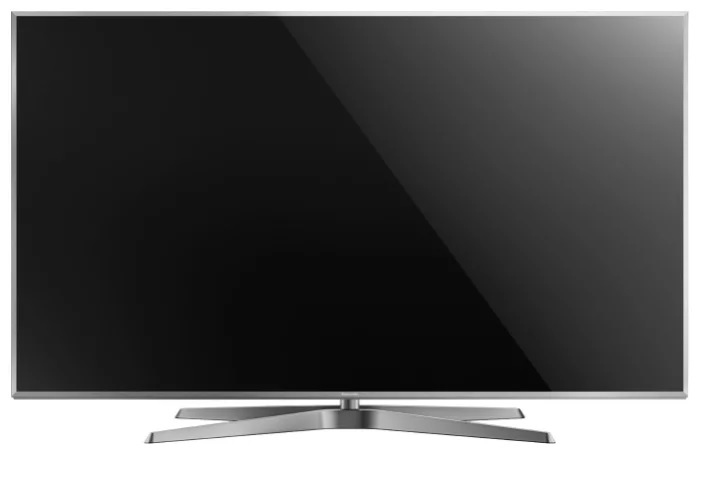
A 74.5-inch LED TV from a Japanese corporation went on sale in 2017, but today its technical capabilities are a real pleasure for customers. The VA matrix with side LED backlighting and local dimming has increased the contrast of the image and the saturation of colors and hues. 4K UHD HDR format gives you the feeling of being completely immersed in the shown scenes. The device receives signals from digital channels in the second version of DVB formats for satellite, cable and terrestrial television. Smart TV allows you to use the device like a computer. The Time Shift function is very interesting, which allows you to record on-air programs with their subsequent viewing at any convenient time. For contacts with PC, tablets and smartphones, there are USB and HDMI ports. There is Wi-Fi and Bluetooth.
Advantages:
- matrix with LED backlight and local dimming function;
- large viewing angles;
- many additional useful functions.
Disadvantages:
- not identified.
| Panasonic TX-75FX780 74.5 '' | LCD TV |
|---|---|
| Diagonal screen size | 74.5 '' = 189 cm |
| Format | 1970-01-01 16:09:00 |
| Resolution | 4K UHD (3840x2160p) |
| Backlight | LED, side |
| Matrix | TFT MVA |
| Built-in acoustics | 2x10 W |
| entrance | AV; HDMIх4; USBх2; Ethernet; Bluetooth; Wi-Fi; Miracast |
| Additionally | Local home network (DLNA) support |
| Smart TV implementation | On Firefox OS platform |
| Dimensions mm. | 1689x996x70 |
| Weight | 54 kg |
| average price | 99,900 rubles |
6. Philips 75PUS6754 75 "
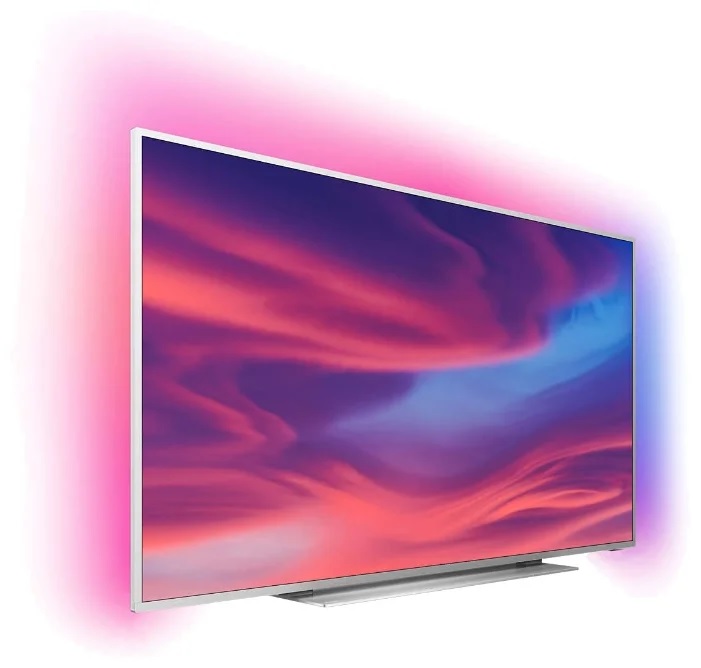
New for the 2019 season of the famous company Philips (Netherlands). 75-inch LCD TV 4K UHD. Equipped with a VA matrix with side LED backlighting. All "bells and whistles" are similar to the previous models. Unique LED three-sided illumination improves visual perception of color reproduction. However, the lack of a local dimming function reduces the contrast compared to models with this capability. In all other respects - "full stuffing", including Smart TV, the ability to receive digital formats DVB for satellite, cable and terrestrial TV, with updated versions, connectors for USB and HDMI, Wi-Fi and bluetooth.
Advantages:
- diagonal 75 inches;
- 4K UHD resolution;
- stylish design;
- "Omnivorous" built-in media player;
- TimeShift function.
Disadvantages:
- no local dimming of the matrix;
- high price.
| Philips 75PUS6754 75 '' | LCD TV |
|---|---|
| Diagonal screen size | 75 '' = 191 cm |
| Format | 1970-01-01 16:09:00 |
| Resolution | 4K UHD (3840x2160p) |
| Backlight | LED |
| Built-in acoustics | 2x10 W |
| entrance | AV; HDMIх3; USBх2; Ethernet; Bluetooth; Wi-Fi; Miracast |
| Smart TV implementation | On the Saphi platform |
| Dimensions mm. | 1683x988x278 |
| Weight | 34.1 kg |
| average price | 99,900 rubles |
5. Samsung UE 75RU 7100U 74.5 "(2019)
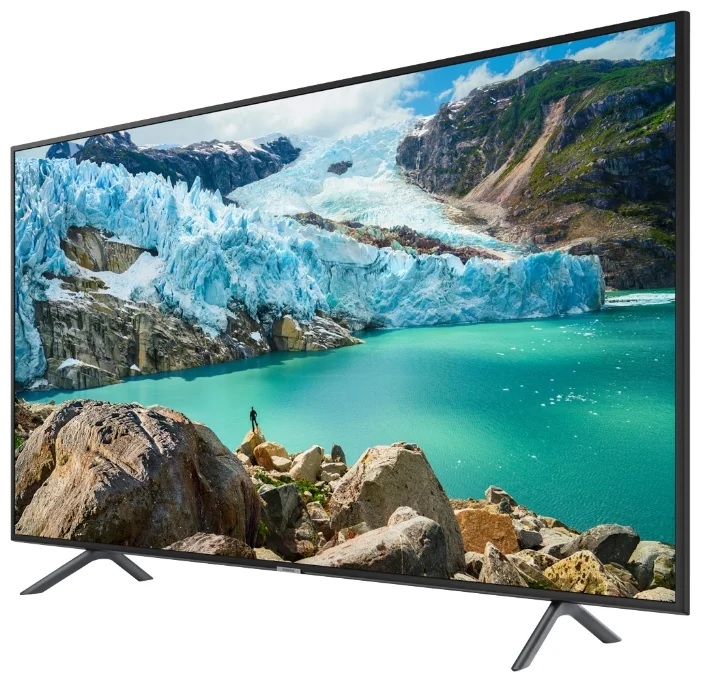
Another novelty of last year's season is a 4K LED TV from Samsung, with a side LED backlit matrix. Realistic light transmission and ultra-clear images will allow viewers to become participants in the events unfolding on the screen. Digital tuners make it possible to watch satellite and cable channels. Smart TV is supported by a quad-core processor. Internet connection is provided by a built-in Wi-Fi module. With USB HID support, you can connect a mouse and keyboard to the device. Movie fans and gamers alike will be delighted.
Advantages:
- diagonal 75 inches;
- built-in 4-core processor;
- built-in digital tuners.
Disadvantages:
- the function of local dimming is not implemented;
- high price.
| Samsung UE 75RU 7100U 74.5 '' | LCD TV |
|---|---|
| Diagonal screen size | 74.5 '' = 189 cm |
| Format | 1970-01-01 16:09:00 |
| Resolution | 4K UHD |
| Backlight | LED |
| Built-in acoustics | 2x10 W |
| entrance | HDMIх3; USBх2; Ethernet; Bluetooth; Wi-Fi; Miracast |
| Additionally | Local home network (DLNA) support |
| Dimensions mm. | 1685x966x60 |
| Weight | 37 kg |
| average price | 100,500 rubles |
4. Xiaomi Mi TV4 75 74.5 ''
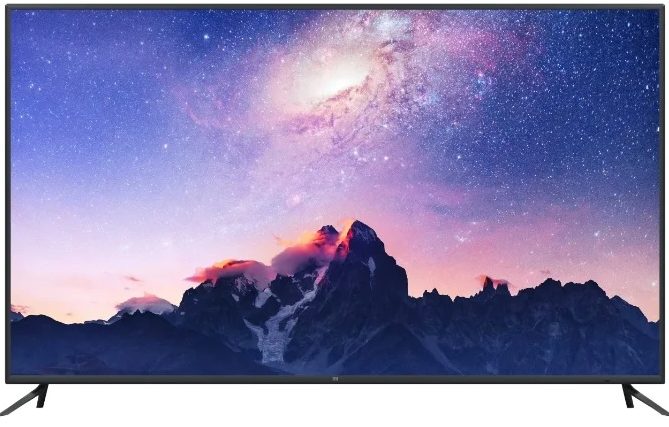
A Chinese corporation specializing in the design and manufacture of smartphones, tablets and smart things for ecosystems is represented in our review by a 4K UHD LSD TV with a diagonal of 74.5 inches, 16: 9 aspect ratio. LED side illumination of the matrix provides high quality color reproduction. Due to the lack of local dimming, contrast is poor. The device is "stuffed" with the functions of a smart TV, wireless Internet connection, built-in tuners, a media player and other "bells and whistles" to the delight of gamers. The 178 ° viewing angle is a joy for moviegoers. The built-in acoustics consists of two 8W speakers. This is enough for normal viewing of terrestrial channels. To watch Blu-ray discs, you will have to fork out for a suitable soundbar. To connect third-party devices, there are USB, HDMI, Ethernet, Wi-Fi connectors.
Advantages:
- diagonal 74.5 '';
- built-in tuners;
- Smart TV.
Disadvantages:
- no local dimming function;
- the price bites.
| Xiaomi Mi TV 4 75 74.5 '' | LCD TV |
|---|---|
| Diagonal screen size | 74.5 '' = 189 cm |
| Format | 1970-01-01 16:09:00 |
| Resolution | 4K UHD (3840x2160p) |
| Backlight | LED, side |
| Built-in acoustics | 2x8 W |
| entrance | HDMIх3; USBх2; Ethernet; Bluetooth; Wi-Fi; AV; Miracast |
| Additionally | Local home network (DLNA) support |
| Smart TV implementation | Yes |
| Dimensions mm. | 1686x1043x307 |
| Weight | 36 kg |
| average price | 102450 rubles |
3 Sony KD-75XG8096 74.5 "(2019)
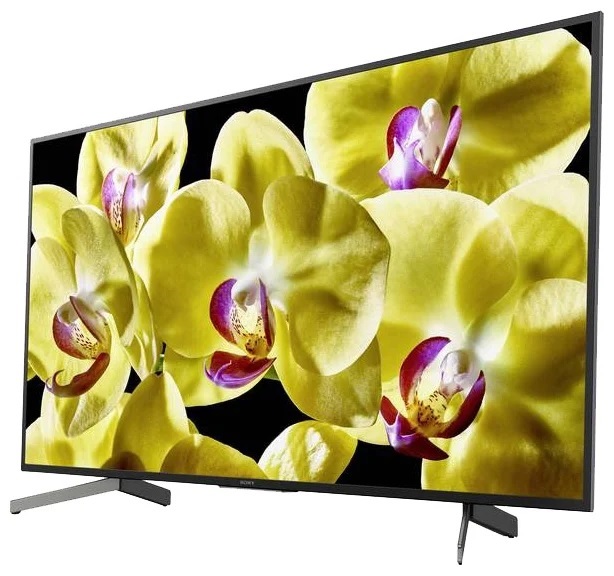
In third place is the novelty of last year's season from the Japanese transnational corporation Sony. The developers have tried to saturate their device with all the new products that form the highest quality image, while maintaining a relatively affordable price. IPS matrix with LED Direct backlighting and local dimming function, provides excellent contrast and color reproduction. 4K UHD and HDR10 support let you receive and display ultra high quality content. Watching action movies and fantasy on such a device will make the user feel at the center of events unfolding on an almost two-meter diagonal screen.
For the sake of completeness, it is advisable to purchase a "native" soundbar with a powerful subwoofer from this TV. A built-in speaker system is enough to watch terrestrial TV channels. Built-in tuners, Smart TV, multiple inputs for HDMI¸USB, Wi-Fi, Bluetooth, Miracast - there is it all! The average price of this splendor is 114,000 rubles.
Advantages:
- diagonal 74.5 inches;
- 4K UHD, HDR resolution;
- IPS matrix with LED Direct backlight;
- local dimming function.
Disadvantages:
- high price.
| Sony KD-75XG8096 74.5 '' (2019) | LCD TV 2019 |
|---|---|
| Diagonal screen size | 74.5 '' = 189 cm |
| Format | 1970-01-01 16:09:00 |
| Resolution | 4K UHD (3840x2160p) |
| Backlight | LED, full array |
| Matrix | TFT IPS |
| Built-in acoustics | 2x10 W |
| entrance | HDMIх4; USBх3; Ethernet; Bluetooth; Wi-Fi; Miracast |
| Additionally | Local home network (DLNA) support |
| Smart TV implementation | On Android platform |
| Dimensions mm. | 1686x970x80 |
| Weight | 30.7 kg |
| average price | 120,000 rubles |
2 QLED Samsung QE75Q60RAU 75 "(2019)
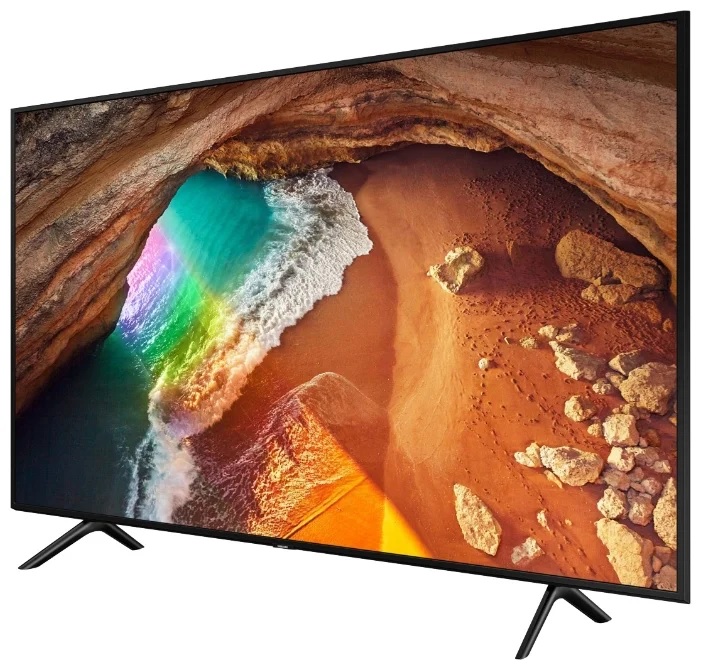
The device from the South Korean corporation Samsung is interesting because the developers have applied the Quantum Dot technology (quantum dots) in it. This is a kind of response to the development of OLED (organic light-emitting diodes) from LG. Two fundamentally different technologies are used to achieve the most realistic color reproduction.
In all other respects, the QLED Samsung QE75Q60RAU 75 "(2019) model is not much different from the devices of other manufacturers: a rich set of additional functions, interfaces, support for all multimedia formats, tuners. The device fits into the smart home system from Yandex. There are also new items - the interior Ambient mode. A device attached to the wall, even when turned off, can completely merge with the background, or display art canvases, show weather forecasts or display news. The device is equipped with a multi-brand remote control.
Implemented voice control function. The picture quality is excellent. 4K UHD HDR resolution, HDR10 format, HDR10 +, quantum dot technology, provide excellent saturation, clarity and brightness of the image.
Advantages:
- diagonal 191 cm;
- rarefaction 4K UHD HDR;
- a matrix made using quantum dot technology;
- Ambient mode.
Disadvantages:
- high price.
| QLED Samsung QE75Q60RAU 75 '' (2019) | LCD QLED TV |
|---|---|
| Diagonal screen size | 75 '' = 191 cm |
| Format | 1970-01-01 16:09:00 |
| Resolution | 4K UHD (3840p) |
| Backlight | LED, full array |
| Built-in acoustics | 2x10 W |
| entrance | HDMIх4; USBх2; Ethernet; Bluetooth; Wi-Fi |
| Compatible with the "Smart Home" system | Yandex |
| Dimensions mm. | 1683x965x60 |
| Weight | 38.9 kg |
| average price | 114,000 rubles |
1 OLED Sony KD-77A1 76.7 "

Apparatus with a matrix. made with OLED technology, with 4K UHD HDR resolution, picture quality and color saturation, gets the best, sometimes just rave reviews from customers. In terms of image brightness, it is somewhat inferior to devices with QLED matrices, but you can see this difference only when you have two different devices in front of your eyes.
The set of basic and additional functions is complete. Unlike the previous model, there are no interior features here. The screen refresh rate of 120 Hz is not the highest, but for 4K resolution and a diagonal of 195 cm, this is quite enough. Only the high price is depressing. But so far OLED TVs remain the most expensive.
Advantages:
- diagonal 195 cm;
- 4K UHD HDR resolution;
- OLED matrix.
Disadvantages:
- extremely high price.
| OLED Sony KD-77A1 76.7 '' | OLED TV |
|---|---|
| Diagonal screen size | 76.7 '' = 195 cm |
| Format | 1970-01-01 16:09:00 |
| Resolution | 4K UHD (3840x2160p) |
| Screen Refresh | 120 Hz |
| Built-in acoustics | 5x10W (including subwoofer) |
| entrance | HDMIх4; USBх3; Ethernet; Bluetooth; Wi-Fi |
| Additionally | Local home network (DLNA) support |
| Dimensions mm. | 17218x997x99 |
| Weight | 45.3 kg |
| average price | 1,200,000 rubles |
In the old days, choosing a TV was not difficult. Come to the store, choose the one that brightly and clearly shows and looks more beautiful. Today, the presence of a huge number of characteristics, and even not in Russian, confuses many inexperienced buyers. What to take: LED or OLED, or maybe QLED It will be enough FULL HD, or swing at 4K UHD. whether it is worth paying for them. The editors of the site hope that our review will be useful to those who are going to buy a new TV, and will help not to make mistakes when choosing.












